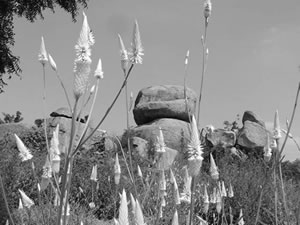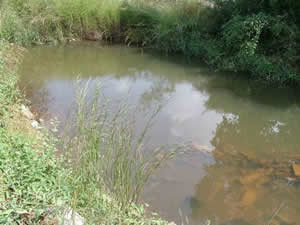- Ragoo Rao
Development is imminent. It cannot be stopped. It can only be stalled for some time. Development is often thought of as destruction of some other thing, but it need not be so. Urban development is one such imminent thing. It cannot halt.
It need not necessarily destroy anything else. It can be planned keeping our fragile environment in mind and going harmoniously with it than against it.
 A perfect testimony of this is ...”The Indian School of Business (ISB)”… which has shown the way.
A perfect testimony of this is ...”The Indian School of Business (ISB)”… which has shown the way.
Nestled deep in a scrub- jungle range, about twenty kilometers away from Hyderabad in a locality known as Gachibowli, this state-of- the art premiere business institution reflects its perfect harmony with nature. It is spread over a
sprawling area of around two hundred acres with high rise buildings and strategically located student villages. Despite this, it has managed to retain the pristine condition of the scrub-jungle. The terrain is rocky with huge boulders of granite- some being
monolithic; rising almost twenty feet from the ground. The range has a lot of thorny shrubs, huge trees, natural ravines interspersed with natural cascading small brooks and small ponds. It is a typical scrub- jungle and everything is untouched. The buildings
are so well and aesthetically planned that nature and man-made structures compliment each other. In fact, one of their buildings has a monolithic granite deposit as one of its walls. It's a marvelous merging of nature with development.
 |
The ISB campus has its own preserved ecosystem comprising of abundant flora-fauna. Adding life to such a setting are the resident Peafowl, Quail, Partridges, Sunbirds, Shikras, Bee-eaters, Baya weaverbirds with their hanging nests around
the ponds, Egrets, Herons, Mynas, Warblers, Tailor birds, Cuckoos, Coucals,….and the list could go on and on. The main attraction being the magnificent Peacocks which adorn the campus.
The common mongoose is frequently seen looking for prey around the buildings. Chameleons are in abundance here and can be spotted on almost every second Neem tree. The birds and animals here are well protected and respected. Even to
venture into the area and photograph them the ISB insists on a written permission from the Administration. In short it is mainly a Nature Sanctuary also housing the ISB. As one enters the ISB through their only main gate-after a strict security check, boards
can be seen on all driveways instructing drivers to drive slow and look out for well shown “Peacock crossing” sign boards. “Nature truly has the right of way here.”
A day spent in the ISB campus is a memorable one for any nature lover. As dawn ascends on the huge boulders and scrub-jungle, it spreads a spectacular golden glow on the rocks and one can hear the shrill cry of a peacock close by. It
is answered by another distant cry of another peacock, and then another somewhere else and in a few minutes the whole place is filled with a chorus of shrill peacock calls. Then suddenly they stop, only to return to the chorus after a few minutes. At the first
break of light it is a delight to see from one's window…the peacocks, an entire flock of them on a boulder socializing & preening.
 |
As the day starts getting brighter, the other birds like the Sunbirds are out to get to the first blooms of the wild flowers to get their morning nectar. On the ground, in the tall grass the Partridges are out cackling and scratching
the ground for grass seeds. The warblers are out hopping from shrub to shrub in search of insects. The Herons and Egrets scan the lawns of the campus for crickets and small frogs. Each one going about its life the way nature designed it, unmindful of the regular
security guard doing his morning rounds in the jungle.
Suddenly, the Squirrels, who until then were busy chasing each other from branch to branch, go into a fit of shrill alarm calls. Watch carefully and you'll find either a Mongoose on the prowl or a Shikra scanning the scene from a nearby
branch.
As we approach the brighter & warmer mid-day, the orchestra and drama of these animals and birds fade away and one could only hear the gurgling sound of a nearby brook and an occasional egret take-off from one of the ponds.
The evening sets a different scenario; the peacocks are quietly foraging like domestic hens all around the campus, blissfully ignorant of a passing car or the residents walking around or the children playing. The male Baya weaver birds
are all gathered near the pond in the high reeds trying to show off their nest building capabilities and the choosy female birds inspecting one nest after the other. The Green bee- eaters, in flocks of hundreds, are all perched on the electric wires of the
campus in trying to catch an insect in the late evening.
Dusk is heralded by a grand finale-orchestra of the peacocks once again all perched up on their favorite trees, only to be seen as silhouettes against the velvety dark sky. Everything is quiet in the campus, with the sight of eerie silhouettes
of the mammoth boulders against the star filled sky, until the next dawn, when the drama starts unfolding itself again, each player doing his role precisely as nature directs.
This is what proper planning of development means. LIVE AND LET LIVE….Indeed… The ISB shows the way.
As experienced by Ragoorao. Photographs by author
(October 2005)